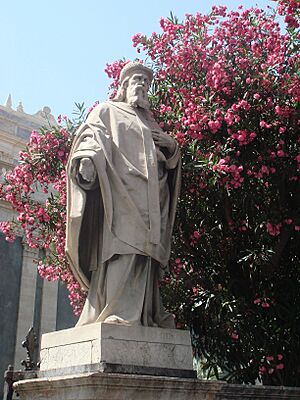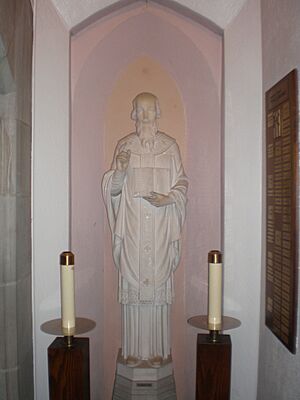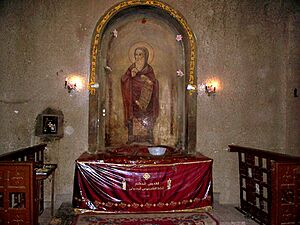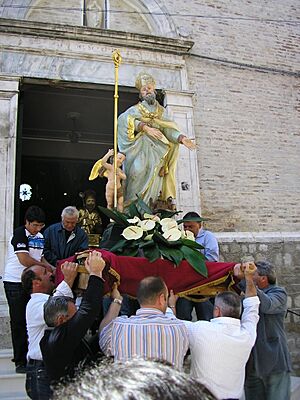Athanasius of Alexandria facts for kids
Quick facts for kids Athanasius of Alexandria |
|
|---|---|
| Pope of Alexandria | |
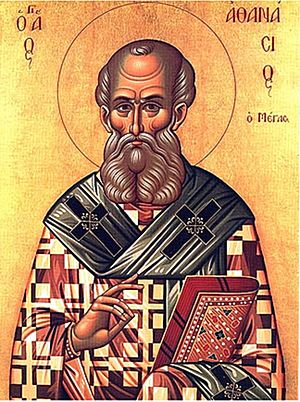
Icon of St Athanasius
|
|
| Church | Nicene Christianity |
| See | Alexandria |
| Predecessor | Alexander |
| Successor | Peter II |
| Personal details | |
| Born | c. 296–298 Alexandria, Roman Egypt |
| Died | 2 May 373 (aged 75–77) Alexandria, Roman Egypt Philosophy career |
|
Notable work
|
|
| Era | Patristic Age |
| School |
|
|
Main interests
|
Theology |
|
Notable ideas
|
Consubstantiality, Trinity, divinity of Jesus, Theotokos |
| Sainthood | |
| Feast day |
|
| Venerated in | |
| Title as Saint | Saint and Doctor of the Church |
| Attributes | Bishop arguing with a pagan; bishop holding an open book; bishop standing over a defeated heretic (Arius) |
| Shrines | Church of San Zaccaria in Venice, Italy and St Mark Coptic Orthodox Cathedral in Cairo, Egypt |
Athanasius I of Alexandria (c. 296–298 – 2 May 373) was an important Christian leader. He is also known as Athanasius the Great. Among Coptic Christians, he is called Athanasius the Apostolic. He served as the 20th Pope of Alexandria.
Athanasius was a key figure in early Christian history. He was a strong defender of the idea of the Trinity. This belief states that God is one, but exists as three persons: the Father, the Son (Jesus), and the Holy Spirit. He argued against a group called the Arians. They believed that Jesus, the Son of God, was created by God and not equal to Him.
His life was full of challenges. He was exiled (sent away from his home) five times by different Roman emperors. This is why he was known as Athanasius Contra Mundum (Latin for 'Athanasius Against the World'). Despite these difficulties, he became a highly respected leader. He is considered a saint in many Christian churches today.
Contents
Biography
Athanasius was born into a Christian family in Alexandria, Egypt. This was around the years 296 to 298 AD. Alexandria was a very important city at that time. It was a major center for trade and learning.
Early Life and Education
Athanasius's parents were wealthy enough to give him a good education. He learned Greek, which was important for writing his works. He also knew Coptic, the language spoken by many Egyptians.
A story says that when he was a boy, Bishop Alexander of Alexandria saw him playing. Athanasius was pretending to be a bishop and baptizing his friends. Bishop Alexander was impressed by his seriousness. He invited Athanasius and his friends to prepare for church careers.
Athanasius became a deacon (a church assistant) in 319 AD. In 325, he served as secretary to Bishop Alexander at the First Council of Nicaea. This was a very important meeting of Christian leaders.
The Council of Nicaea
The First Council of Nicaea was called by Emperor Constantine the Great in 325 AD. Its main goal was to settle the debate with Arius and his followers. Arius taught that Jesus was not fully God, but was created by God.
At the council, Athanasius strongly argued against Arius. The council decided that Jesus was "consubstantial" (meaning "of the same substance") with God the Father. This idea became part of the Nicene Creed, a statement of Christian belief. This decision was a big win for Athanasius and his views.
Becoming Patriarch
After Bishop Alexander died, Athanasius was chosen to be the new Pope of Alexandria. This happened around 328 AD. He was about 30 years old. Many people wanted him to be their leader. However, the followers of Arius and other groups opposed him.
Athanasius's time as patriarch lasted 45 years. During this time, he faced many challenges. He was exiled five times by different Roman emperors. He also had to flee Alexandria several other times to stay safe.
First Exile
Athanasius's first major problem was with the Meletians and Arians. They accused him of treating them badly. In 335, a meeting of bishops decided to remove Athanasius from his position.
Emperor Constantine I then sent Athanasius into exile. He was sent to Trier, a city in Gaul (modern-day Germany). He stayed there for two years. Constantine died in 337, and Athanasius was allowed to return home.
Second Exile
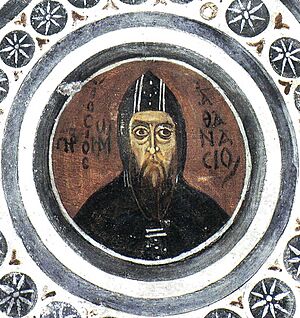
Soon after his return, Emperor Constantius II ordered Athanasius to be banished again in 338. Athanasius went to Rome to ask for help from Pope Julius I. The Pope supported Athanasius.
A council of bishops in Rome declared Athanasius innocent. But an Arian bishop named Gregory was put in charge of Alexandria in Athanasius's place. Athanasius still kept in touch with his people through letters.
In 343, another council was held in Serdica (modern-day Sofia). This council also confirmed Athanasius's innocence. Despite this, the persecution against Athanasius continued. He had to stay away from Alexandria for several years.
Eventually, Emperor Constantius II changed his mind. He allowed Athanasius to return to Alexandria in 345. This brought a period of peace for about ten years.
Third Exile
In 355, a council was held in Milan. Emperor Constantius, who supported the Arians, forced the bishops to condemn Athanasius. Athanasius's friends were scattered, and he could not escape.
On February 8, 356, armed men tried to arrest him during a church service. Athanasius escaped and went into hiding in the deserts of Upper Egypt. He stayed there for six years, living with monks. During this time, he wrote many important works.
Emperor Constantius died in 361. The new emperor, Julian, allowed exiled bishops to return. Athanasius came back to Alexandria on February 22, 362.
He called a council in Alexandria to promote unity among Christians. He worked to clarify the meaning of the Nicene Creed. However, Julian soon ordered Athanasius to leave Alexandria again.
Fourth Exile
In 362, Emperor Julian, who was against Christianity, ordered Athanasius to leave Alexandria once more. Athanasius went to Upper Egypt and stayed with the Desert Fathers. He remained there until Julian died in 363.
The next emperor, Jovian, allowed Athanasius to return. Athanasius quickly called another council to confirm the Nicene Creed. He even met with Emperor Jovian, who asked him to explain the Christian faith. Jovian died in 364.
Fifth Exile
The next emperor, Valens, supported the Arians. He issued a decree banishing bishops who had returned. Athanasius quietly left Alexandria in October 364 and stayed in a country house nearby.
However, Emperor Valens soon realized that banishing Athanasius could cause problems with the people. Within a few weeks, he allowed Athanasius to return to his position.
Final Years and Death
After his last return, Athanasius spent his final years rebuilding the church. He continued to write and preach without further interruptions. He focused on teaching about the Incarnation, the belief that God became human in Jesus.
Athanasius died peacefully on May 2, 373. He was surrounded by his clergy and supporters. He had appointed Peter II as his successor.
Works
Athanasius was one of the first patriarchs of Alexandria to write in both Coptic and Greek.
Theological Works
Athanasius was not just a thinker; he was a strong defender of Christian beliefs. He believed in "the tradition, teaching, and faith proclaimed by the apostles." He taught that both Jesus (the Son of God) and the Holy Spirit are fully God, just like the Father. This idea was very important for the development of the Trinity doctrine.
His book "Letter Concerning the Decrees of the Council of Nicaea" is an important historical account of that council. He also wrote Orations Against the Arians, where he argued against their views. His Letters to Serapion defended the divinity of the Holy Spirit.
One of his earliest works was a two-part book: Against the Heathen and The Incarnation of the Word of God. In the first part, he criticized pagan beliefs. In the second, he explained how God, through Jesus, came into the world to save humanity.
Biographical Works
Athanasius's most famous work is Life of Antony. This book tells the story of Anthony the Great, a Christian monk who lived in the Egyptian desert. The book describes Anthony as a holy man who fought against evil forces. It became very popular and helped spread the idea of monasticism (living a life dedicated to God, often in a community or alone).
Other Works
Some other writings are sometimes thought to be by Athanasius, but this is not certain. One example is the Athanasian Creed, a statement of Christian faith.
Veneration
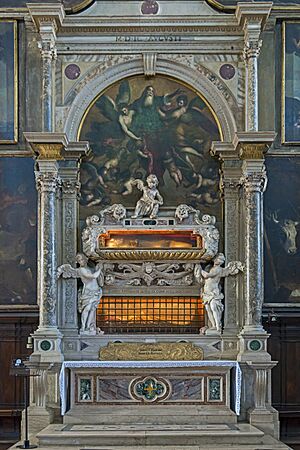
Athanasius is honored as a saint by many Christian churches. He was first buried in Alexandria. Later, some of his remains were moved to Venice, Italy. In 1973, a part of his relics was returned to Egypt and is now in St Mark Coptic Orthodox Cathedral in Cairo.
Western Christians celebrate his feast day on May 2. The Catholic Church considers him a Doctor of the Church, meaning he is a highly respected teacher of the faith. Coptic Christians celebrate his feast day on Pashons 7 (around May 15). Eastern Orthodox Christians remember him on January 18.
Gregory of Nazianzus, another important church leader, called Athanasius the "Pillar of the Church." He said that Athanasius's life and teachings were a guide for bishops and for the true Christian faith.
Character
Athanasius is seen as one of the greatest defenders of Christian belief about Jesus. He is often called the 'Father of Orthodoxy'. He lived during a time when many church leaders and even emperors supported Arianism.
A famous saying from that time was that "The whole world groaned and was amazed to find itself Arian." Athanasius stood almost alone against these widespread beliefs. He even faced unfair actions from Pope Liberius. Despite everything, Athanasius remained firm in his faith.
Selected works
- Athanasius. Contra Gentes – De Incarnatione (translated by Thompson, Robert W.), text and ET (Oxford: Clarendon Press, 1971).
- On the Incarnation at theologynetwork.org
- Letters to Serapion (on the Holy Spirit) at archive.org
See Also
 In Spanish: Atanasio de Alejandría para niños
In Spanish: Atanasio de Alejandría para niños
- Arabic Homily of Pseudo-Theophilus of Alexandria
- Eastern Catholic Church
- Eugenius of Carthage
- Homoousian
- Pontifical Greek College of Saint Athanasius
- Saint Athanasius of Alexandria, patron saint archive


